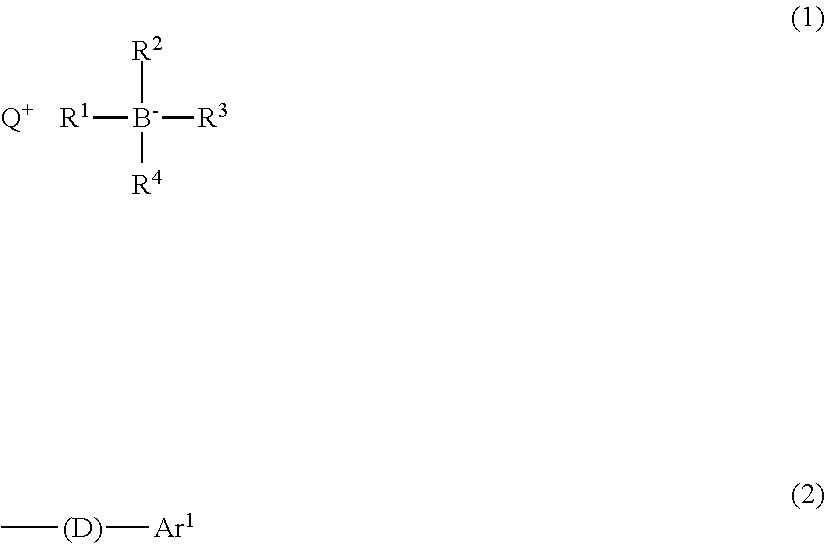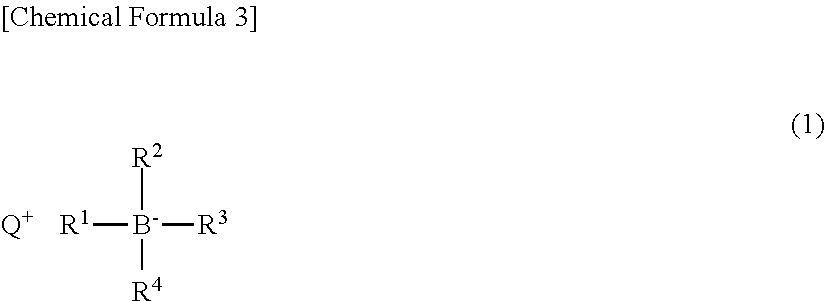Photobase generator
a generator and photobase technology, applied in the field of photobase generators, can solve the problems of large amount of photobase generators, low base generation rate, and inconvenient use of photobase generators, and achieve the effects of low cost, high catalytic activity, and efficient amine generation
- Summary
- Abstract
- Description
- Claims
- Application Information
AI Technical Summary
Benefits of technology
Problems solved by technology
Method used
Image
Examples
production example 1
Synthesis of thioxanthone-3-carboxylic acid (Intermediate a)
(1) Synthesis of 2-(phenylthio)-dimethyl terephthalate (Intermediate a-1)
[0101]In a reaction vessel, the inside of which was replaced with nitrogen, 43 g of dimethyl 2-nitroterephthalate (available from Tokyo Chemical Industry Co., Ltd.) and 100 mL of DMF were placed, and cooled to −10° C. with an ice-salt bath. To this, separately, a sodium thiophenolate solution prepared with 22 g of thiophenol, 8 g of sodium hydride and 60 mL of DMF was added dropwise over a period of 1 hour. The contents were stirred for 3 hours at room temperature, and then, charged into water. After being extracted with ethyl acetate and removed from the aqueous layer, water washing was performed three times and the organic layer was concentrated. The concentrated organic layer was treated with hexane to obtain 45 g of a white solid. It was confirmed by 1H-NMR that this white solid was (Intermediate a-1).
(2) Synthesis of 2-(phenylthio)-terephthalic ac...
production example 2
Synthesis of 2-mercaptothioxanthone (Intermediate b)
[0104]In a reaction vessel, 300 mL of concentrated sulfuric acid was placed, and to this, 16 g of dithiosalicylic acid (available from Wako Pure Chemical Industries, Ltd.) was added in small portions. The contents were stirred for 30 minutes, and cooled to 5° C. with an ice bath. To this, 120 g of thiophenol was added dropwise. After being stirred for 1 hour at room temperature, the contents were allowed to undergo a reaction for 5 hours at 80° C., and then, again cooled to room temperature. To 5 L of water at 80° C., the reaction liquid was added in small portions under stirring. After being cooled to room temperature, a solid precipitated was filtered. The solid was recrystallized from dioxane / water to obtain 22 g of a yellow solid. It was confirmed by 1H-NMR that this solid was (Intermediate b).
production example 3
Synthesis of 2-bromomethylthioxanthone (Intermediate c)
(1) 2-Methylthioxanthone (Intermediate c-1)
[0105]In a reaction vessel, 70 mL of concentrated sulfuric acid was placed, and to this, 10 g of dithiosalicylic acid (available from Wako Pure Chemical Industries, Ltd.) was added and stirred at room temperature for 1 hour. The contents were cooled with an ice bath and 25 g of toluene was added dropwise while keeping the temperature thereof at 20° C. or lower. After dropping, the temperature thereof was returned to room temperature, and furthermore, stirring was performed for 2 hours. This reaction liquid was poured into 800 g of ice water. A yellow solid precipitated was filtered off and dissolved in 200 g of dichloromethane, after which water washing was performed. The organic layer was concentrated to obtain 9 g of a yellow solid. It was confirmed by: 1H-NMR that this yellow solid was Intermediate (c-1).
(2) Synthesis of 2-bromomethylthioxanthone (Intermediate c)
[0106]In a reaction v...
PUM
| Property | Measurement | Unit |
|---|---|---|
| pKa | aaaaa | aaaaa |
| pKa | aaaaa | aaaaa |
| pKa | aaaaa | aaaaa |
Abstract
Description
Claims
Application Information
 Login to View More
Login to View More - R&D
- Intellectual Property
- Life Sciences
- Materials
- Tech Scout
- Unparalleled Data Quality
- Higher Quality Content
- 60% Fewer Hallucinations
Browse by: Latest US Patents, China's latest patents, Technical Efficacy Thesaurus, Application Domain, Technology Topic, Popular Technical Reports.
© 2025 PatSnap. All rights reserved.Legal|Privacy policy|Modern Slavery Act Transparency Statement|Sitemap|About US| Contact US: help@patsnap.com



